Exploring the Intricacies of Coin Collecting
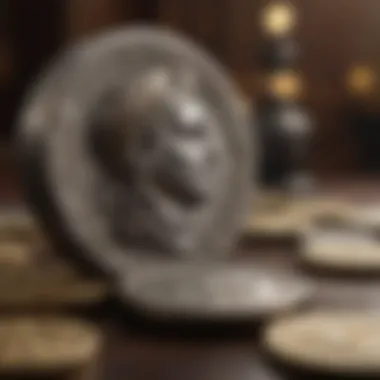
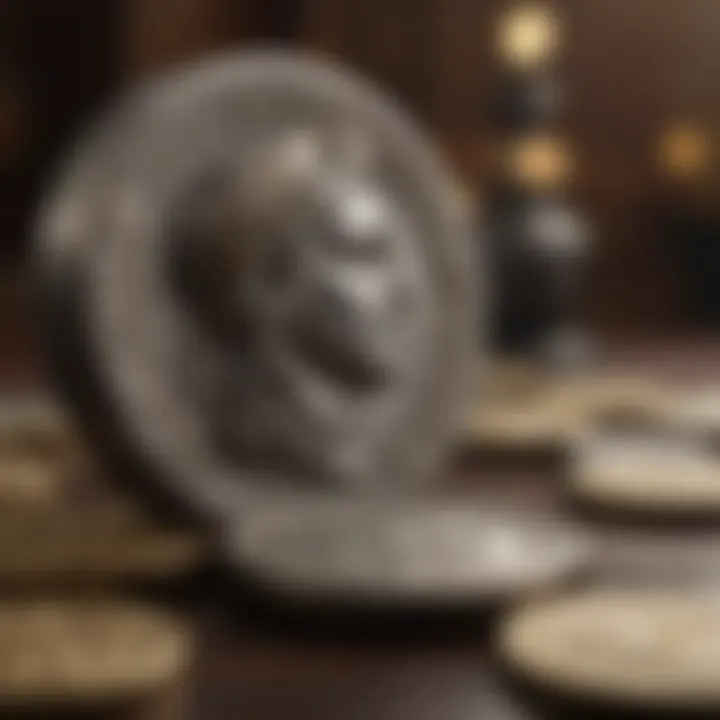
Intro
Coin collecting, often overlooked in the broader financial markets, has a rich history and a unique charm that draws in enthusiasts from all walks of life. It's not just about collecting shiny pieces of metal; it's about discovering stories, cultures, and eras that coins represent. This hobby, known as numismatics, intertwines history with artistry, and for many, it transforms into not just a passion but an investment approach unlike any other.
The art of numismatics extends beyond simply accumulating coins. It involves understanding their historical significance, the nuances of how their value fluctuates over time, and the importance of community within the hobby. From ancient Roman coins to modern commemorative issues, every piece carries weight—not just literally but metaphorically as well.
As we delve deeper, we’ll explore the knowledge required to start and grow a collection. This guide aims to enlighten both novices and seasoned collectors about investment products related to numismatics, the terminology that comes into play, and how technology shapes the landscape of modern coin collecting. Let's embark on this journey together, peeling back layers to find out what truly lies underneath the surface of this captivating pursuit.
Prelude to Numismatics
Numismatics, the study and collection of currency, is a realm that goes beyond mere coins and bills. It’s a gateway into the history, culture, and economics of societies throughout time. When one embarks on the journey of coin collecting, they aren’t just acquiring pieces of metal; they are engaging with stories that span generations, navigating through a tapestry of human civilization.
The interest in numismatics offers a multifaceted approach to understanding our world. Collectors find particular joy in the thrill of the hunt, whether they are seeking rare variations, historical artifacts, or aesthetically pleasing pieces. This article aims to highlight the significance of coin collecting, from its captivating definitions to its rich historical roots, suggesting why it holds a compelling place in the hearts and minds of investors and enthusiasts alike.
But beyond its appeal, numismatics encompasses essential considerations. It provides an excellent means of education concerning economic principles and historical events, deepens appreciation for craftsmanship in design, and allows for financial foresight and security as certain coins appreciate in value over time. Thus, understanding numismatics is not just for the collector but also for anyone interested in the intersections of art, finance, and history.
Defining Numismatics
At its core, numismatics is the systematic study of coins, tokens, paper money, and medallions. The word itself is derived from the Latin "numisma," which refers to currency. It involves various components including the examination, collection, and preservation of numismatic objects. Some might think this is only for the avid collector or the wealthy, but the reality is numismatics is accessible to almost anyone willing to learn and appreciate its nuances.
Coins can tell a lot; the images inscribed on them, their weight, material, and design can reveal insights into the era they originate from and the values of the societies that minted them. Some collectors specialize in specific types of coins, such as ancient coins, modern issues, or coins bearing unique errors, each offering a different flavor of discovery. In truths, numismatics can be seen as a unique blend of artistry and history, creating a bridge between the past and the present.
The Historical Context of Coin Collecting
Coin collecting isn't a new phenomenon; it dates back to antiquity when individuals began to collect rare coins as symbols of status or as a matter of personal interest. The act of accumulating coins has evolved, but its roots run deep in many cultures around the globe.
Consider, for instance, the early Roman emperors who collected coins as a means of power. They would often mint coins with imagery that resonated with their reign, solidifying their legacy for future generations. As time went on, different cultures added their flair, resulting in coins that not only circulated as currency but also became a form of art and communication.
Today, the landscape of numismatics reflects a blend of various eras and cultures, illustrating how society perceives value. For many, the historical significance aids in laying a foundation for understanding contemporary issues related to money—such as inflation, economic stability, or the evolution of barter systems.
The evolution of coin collecting from a pastime of elite collectors to a more democratized space where everyone can participate embodies a significant cultural shift. Online resources and communities have made it feasible for anyone from a curious child to a seasoned adult to dive into this enriching hobby. Collecting coins is no longer just about possession; it’s about participation in an ongoing discourse about history, economy, and even personal identity.
"Coins are history in your hand, offering a tangible connection to the past, while being a lens through which we can view our present."
In essence, numismatics serves as much more than a hobby; it is a discipline that connects people with a past that informs our present and potentially shapes our future.
The Appeal of Coin Collecting
Coin collecting, or numismatics, exudes a certain allure that captivates both novice and experienced collectors alike. This passion extends beyond mere hobby; it intertwines personal history, investment strategy, and artistic appreciation. The magnetic pull of coin collecting can be attributed to several key factors that make it not just appealing, but profoundly rewarding.
Cultural and Historical Value
Each coin embodies a story, echoing the cultural and historical narrative of its time. Coins are not just currency; they represent a tangible connection to civilizations long past. Whether it’s an antique Greek drachma or a modern American quarter, every piece has its own tale to tell.
For instance, consider the venerable Roman denarius—its history traces back to the expansion of Rome and reflects economic shifts over centuries. Collectors often delve into the origins of their coins, unearthing details about ancient trade routes, political events, or even artistic movements. This rich tapestry of history offers more than just a collectible; it fosters an appreciation for how societies evolved and how their currency symbolized their values.
Moreover, through these little discs of metal, collectors can engage with cultural heritage, adding layers of meaning to their collections that go beyond aesthetics.
Aesthetic Appreciation and Design
The artistic craftsmanship inherent in coin design is another compelling facet of numismatics. Coins are mini canvases, often featuring intricate designs that reflect the artistic trends of the era. Take, for instance, the beloved Kennedy half dollar; its stylish depiction of one of America's iconic figures evokes a sense of nostalgia and pride. The detailed engravings, the quality of minting, and sometimes even the choice of metals contribute to an overall sensory experience that many collectors find irresistible.
When holding a coin, one might notice the subtle variations in texture and the intricate details that make each piece unique. Collectors often appreciate the work of engravers who, with their delicate strokes and creative visions, immortalized aspects of their societies. That is where art marries history, creating a treasure that collectors feel compelled to preserve.
The Psychological Aspects of Collecting
Collecting coins also taps into complex psychological underpinnings. The thrill of the hunt energizes many hobbyists, giving them a sense of purpose and accomplishment, akin to a treasure seeker on a quest. Finding a rare piece or completing a collection often leads to a dopamine rush, fostering satisfaction.
Moreover, coin collecting offers a safe haven for some. In a world marked by uncertainty, coins can provide a sense of stability and a tangible asset that people can hold onto. Others engage in collecting as a way to connect with peers, fostering community through shared interests in their local clubs or online forums.


"Coin collecting is like a time capsule; every piece you hold is a snapshot of history waiting to be explored."
The emotional connection often extends beyond the coins themselves; it also includes the relationships formed with fellow collectors or mentors who share the same passion. Such connections can lead to an enriching social landscape, weaving a network of individuals who exchange knowledge, stories, and collectibles alike.
Types of Coins and Collecting Disciplines
Understanding the types of coins and collecting disciplines is essential for anyone stepping into the world of numismatics. Not only does it broaden the horizon of collecting, but it also aligns the collector's passion with their goals. Each discipline unveils its unique history and significance, influencing both value and appeal. As we delve deeper, it’s worth noting how different types can enhance one’s collection beyond mere monetary value; they can bring personal satisfaction and a sense of accomplishment to collectors, whether novices or seasoned pros.
Ancient Coins
Ancient coins carry with them the weight of history. These pieces, often bearing intricate designs from civilizations such as the Romans and Greeks, are more than just currency; they are artifacts that reflect the culture and economy of their time. Collectors often find joy in unearthing stories from ancient empires. For instance, a silver drachm from the Athenian city-state offers insight into the region's trade practices and political power dynamics.
There's also an undeniable thrill in holding a coin that has traversed centuries. However, accumulating ancient coins comes with its own challenges, as authenticity and condition are paramount. Collectors must navigate the market with careful consideration, as many replicas exist.
Modern Coins
Modern coins, produced from the late 19th century onwards, represent a dynamic area in numismatics. These coins often showcase advanced minting techniques and designs that encapsulate contemporary art and culture. For example, the American Silver Eagle, first minted in 1986, appeals to both collectors and investors alike due to its purity and design by Adolph A. Weinman.
What distinguishes modern coins from their ancient counterparts is the ongoing minting and availability. While some might focus solely on collecting limited edition coins, others may venture into completing sets, providing a continuous challenge and goal. The market for modern coins can also fluctuate based on trends, making it a captivating yet unpredictable field.
Commemorative Coins
Commemorative coins hold a special place in the hearts of collectors, as they often celebrate significant events, anniversaries, or anniversaries of historical figures. The United States Mint frequently produces such coins, like the 50 State Quarters program that began in 1999 and quickly gained popularity.
Collecting these coins involves a layer of sentimentality that transcends their financial value. They serve as tangible reminders of milestones and cultural heritage. However, it's important to assess the market carefully, as some commemoration issues may lose popularity and, consequently, their value, while others could appreciate over time based on scarcity and demand.
Error Coins
Error coins present a fascinating twist in the collecting narrative. These pieces are often fascinating anomalies resulting from mistakes during the minting process. For instance, a coin with a double strike or a wrong planchet error can capture the interest of collectors due to their rarity.
While some error coins can be worth a small fortune, it’s crucial to understand their origins and ensure authenticity. Relying on industry experts and grading services can aid collectors in distinguishing genuine errors from mere damaged coins, preserving the integrity of their collection.
Bullion Coins
Bullion coins, often made from precious metals such as gold, silver, platinum, or palladium, represent both a method of investment and a collector’s passion. The American Gold Eagle is a prime example, often sought after for its intrinsic metal value alongside its collector's appeal. These coins are typically minted with a fixed quantity of precious metal, making them a tangible asset in financial planning.
The fluctuation of precious metal prices impacts bullion coins significantly, adding an element of investment strategy to the collecting aspect. Thus, collectors might focus on acquiring not only rare coins but also those with a strong investment potential, balancing passion with prudent financial decisions.
Collectors often remark on how a diverse range of coins enriches their experience, merging personal interests with historical exploration and financial savvy.
In summary, the various types of coins and their respective collecting disciplines highlight the multifaceted nature of numismatics. Engaging with these categories encourages deeper knowledge, appreciation, and respect for the role coins play in human history and personal narratives.
Valuation of Coins
Understanding the valuation of coins is crucial for both new and experienced collectors. This component of numismatics not only dictates the potential investment return but also enhances the collector's appreciation for the pieces they own. Knowing how to accurately assess a coin's value can help guide purchasing decisions and inform strategies for selling or trading within the marketplace. Factors that affect coin value are numerous and complex, ranging from the historical significance of a coin to its physical condition. A strong grasp of these principles allows collectors to navigate the evolving landscape of coin collecting with confidence.
Factors Affecting Value
Several intertwined factors come into play when determining the value of a coin. Among them are:
- Rarity: Coins that are in scarce supply tend to command higher prices. This might be due to low mintage or limited availability in good condition.
- Demand: If a specific coin is highly sought after, its value can soar. Trends often shift due to various interests, including historical events or notable figures.
- Condition: The physical state of a coin is paramount. Coins are typically graded on a scale from one to seventy; the higher the grade, the more valuable the coin is likely to be.
- Historical Significance: Coins tied to significant events or figures often fetch a premium. This might include coins commemorating notable anniversaries or those with unique features.
- Market Trends: Like any collectible, the value of coins can fluctuate based on broader economic conditions and collector trends.
These factors weave together to create a multifaceted picture, essential for appraising coins effectively.
Grading Systems
Grading is another fundamental aspect of valuing coins. Various grading systems exist, and they provide a standardized method of assessing a coin's condition. The most widely recognized system in the United States is the Sheldon Scale, ranging from one to seventy.
- Mint State (MS): Coins in perfect or near-perfect condition fall into this category, usually grading from MS60 to MS70.
- Circulated Grades: Coins that have been in circulation are marked with grades like Fine (F), Very Fine (VF), or Extremely Fine (XF). These grades evaluate wear and the preservation of details.
- Professional Grading Services (PGS): Numerous reputable services provide professional grading. These companies offer third-party evaluations, lending authority to the grades assigned to coins. Utilization of these services can assure buyers and sellers that the coin’s valuation is sound.
Understanding grading is crucial in the numismatic marketplace; it can dictate buying, selling, and even insuring a collection.
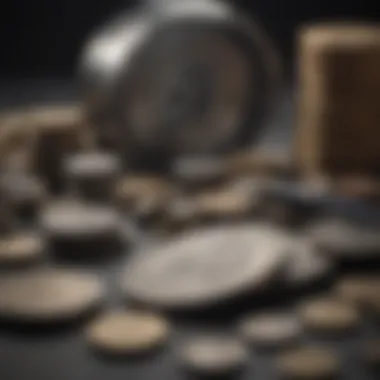

Market Trends and Auctions
The coin market is not static. Valuation can vary broadly based on market dynamics. One significant indicator of a coin's value is its performance in auctions. High-profile auction houses, like Heritage Auctions and Stack's Bowers, often set prevailing market values.
When participating in auctions, it's wise to consider:
- Market Conditions: The economic climate affects disposable income among collectors, thus impacting auction prices.
- Auction House Reputation: Established auction houses often yield higher values due to their credibility and reach.
- Timing: Seasonal shifts can influence auction success. For example, certain times of year may see heightened interest in particular coins based on anniversaries or events.
"The coin collecting market is like a living organism; it breathes, grows, and sometimes contracts. Keeping an eye on trends is essential for valuing your collection effectively."
Collecting Strategies and Best Practices
Coin collecting is not just about amassing shiny pieces of metal; it's about developing a strategic approach that enhances both your experience and your collection's value. Whether you are a novice just stepping into the world of numismatics or a seasoned investor with a keen eye for rare finds, having solid collecting strategies and best practices is crucial. This section will outline the core elements involved in creating an impactful collection, discuss the benefits of strategic focus in numismatics, and touch on considerations that every collector should ponder.
Setting Goals for Your Collection
Establishing clear, attainable goals for your coin collection is like plotting a map before embarking on a journey. Take a moment to think: what are you hoping to achieve? Do you want to focus on specific historical eras, or perhaps a certain type of coin like ancient Roman denarii or modern commemorative pieces? By narrowing your focus, you'll be able to allocate your resources more effectively and deepen your knowledge in specific areas.
A well-defined goal not only keeps you on track, but it also adds a sense of purpose to your collecting experience. Without firm objectives, it is easy to stray into territory that dilutes the significance of your collection. Consider writing your goals down and revisiting them periodically. You might even want to set sub-goals that help you achieve larger aspirations. This way, you can celebrate small victories along the way and stay motivated.
Building a Knowledge Base
Knowledge is power in the field of numismatics. A rich understanding of coins, their histories, and their values empowers collectors to make informed decisions and avoid costly mistakes. Invest time in reading books, articles, and online resources about numismatics. Joining forums, websites like reddit.com, and specialized groups on social media platforms can keep you updated and help you connect with other enthusiasts who share your interests.
When building this knowledge base, document your findings and experiences. Consider creating a personal reference guide filled with images, descriptions, and notes about coins you encounter or acquire. This not only sharpens your expertise but allows for a richer, more fulfilling experience within the hobby. As the saying goes, "the more you know, the more you grow."
Networking with Other Collectors
Networking is an invaluable aspect of any collecting hobby, including numismatics. Whether it's through local coin clubs, online forums, or social media branches like facebook.com, the relationships you build can have lasting benefits. Fellow collectors can provide insights, share leads on rare coins, and offer different perspectives you might not have considered.
Engaging with a community of like-minded individuals also opens doors to collaborative endeavors. For example, co-hosting a small exhibit where collectors can display their coins fosters a sense of camaraderie and provides opportunities for education and gathering tips.
Notably, relationships built on trust can lead to some of the best deals; fellow collectors may offer to sell you coins at fair market value simply because they know you will treat their treasures with respect. In this hobby, connections can often be just as valuable as the coins themselves.
In summary, the heart of successful coin collecting lies in establishing strategic goals, enriching your knowledge, and fostering connections within the numismatic community. These elements don’t just elevate your collecting experience – they shape you into a more astute collector, poised for growth.
The Role of Technology in Numismatics
In today's digital age, technology plays a significant role in various fields, and numismatics, the study of coins and currency, is no exception. The advent of technology has transformed how collectors engage with their hobby, providing new tools and resources that streamline processes, enhance communication, and expand access to information. This section explores how technology supports coin collectors and investors, making the pursuit of numismatics not just easier but also more enriching.
A few specific elements that stand out in this discussion include digital coin management tools, online marketplaces and forums, and dedicated apps for collectors. Each of these areas brings forth distinct benefits while also presenting some considerations that collectors should keep in mind.
Digital Coin Management Tools
Managing a coin collection has never been simpler, thanks to the wide variety of digital tools available. Programs and apps designed for coin management allow collectors to catalog their coins efficiently.
- Features of Management Tools:
- These tools help record details like the coin's origin, date of minting, condition, and even its estimated value.
- Many of these tools include features for tracking purchases and sales, which can be useful in assessing the overall performance of a collection over time.
For instance, applications like Coin Manage and Numismatic* offer options tailored for both beginners and seasoned collectors, allowing for detailed record-keeping. Additionally, Collectors.com provides a user-friendly interface for managing various types of collectibles, including coins.
However, as much as these tools can streamline processes, collectors should be cautious about data privacy and vulnerability to technology glitches. Keeping backups of collector databases can prevent losses if something goes wrong.
Online Marketplaces and Forums
The internet has opened up a world of possibilities for coin collectors. Platforms such as eBay and Heritage Auctions host an extensive range of coins where buyers and sellers can connect directly.
- Benefits of Online Marketplaces:
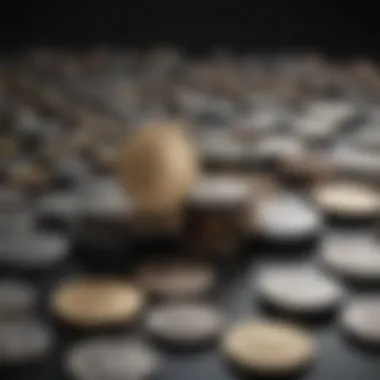
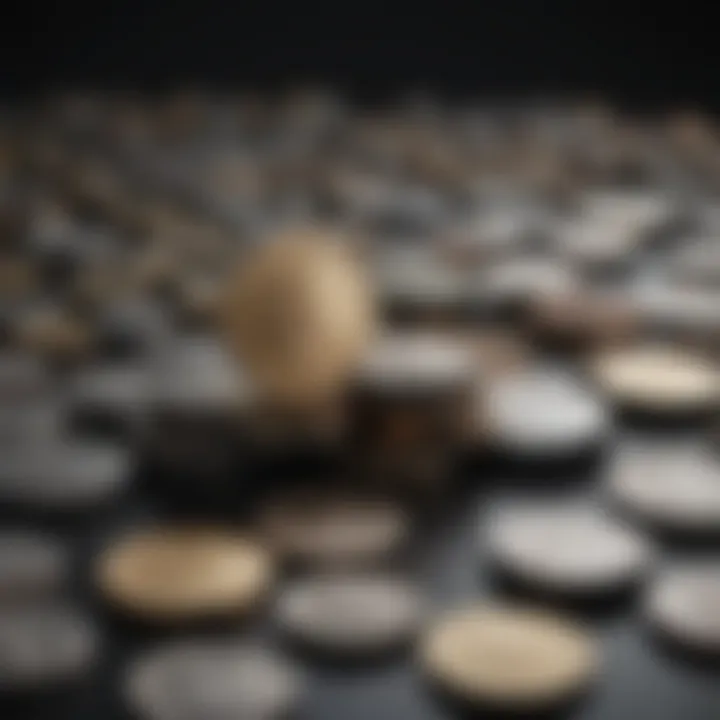
- Instant access to a global network of sellers means collectors can find rare coins they might otherwise never encounter.
- Competitions among sellers can lead to better prices for buyers, creating a dynamic marketplace.
Moreover, forums like reddit.com have carved out spaces for enthusiasts to share insights, ask questions, and engage in discussions about their collections. In such forums, members can exchange tips on finding specific coins, share experiences about dealers, or even post pictures of their collections for feedback.
"In the realm of online numismatics, community interactions can spark not just friendships but also invaluable learning opportunities."
Nonetheless, vigilance is crucial when using these platforms. It is important to verify the authenticity of sellers and coins and understand the terms of service for each platform to avoid pitfalls accompanying online transactions.
Apps for Collectors
Smartphones and tablets have not only changed how we communicate, but they've also revolutionized how we collect, manage, and learn about coins. A plethora of apps dedicated to coin collecting can significantly enhance the experience of numismatics.
- Popular Apps:
- Coinoscope uses image recognition technology to help identify coins, making it easy for collectors to recognize unknown coins.
- PCGS CoinFlation offers valuable insights into the value of coins based on current metal prices, which can help both investors and collectors make informed decisions.
The convenience of having all these resources available at one's fingertips makes coin collecting much more accessible. However, it's essential to choose apps from reputable sources to ensure reliability and to stay updated on their functionalities.
In summary, the integration of technology into numismatics not only simplifies the collecting process but also enriches it. From management to interactions, the digital tools available today promote a vibrant, dynamic environment that caters to both newcomers and seasoned enthusiasts alike.
The Influence of Economic Factors on Coin Collecting
Understanding the influence of economic factors on coin collecting is essential for both collectors and investors. The dynamics of the economy can significantly affect the value and desirability of coins, shaping market opportunities and determining how collectors approach their craft. As we navigate through this subject, it's vital to consider how inflation, currency shifts, and broader economic trends play into the decision-making process for both novice collectors and seasoned investors.
Economics isn't just about numbers; it's about how these numbers interact with human behavior. Collectors often find themselves balancing passion and profit. For some, coins represent pieces of history and art, while for others, they are investment vehicles. Recognizing the delicate interplay between sentimental value and economic context can lead to informed decisions that benefit both the heart and the wallet.
Inflation and Currency Fluctuations
Inflation, that creeping beast that erodes purchasing power, is a significant factor in coin collecting. As prices rise in the general economy, so too can the values of collectible coins, depending on their nature and rarity. Collectors must remain vigilant, watching how economic indicators—like inflation rates—may affect their collections.
Let’s face it: coins aren’t just shiny pieces of metal anymore. They carry narratives and histories that transcend their physical forms. When inflation rises, certain coins, such as historical silver or gold bullion, often see an uptick in interest. Investors look for tangible assets to hedge against inflation, causing demand for precious metal coins to sometimes skyrocket. Here are a few considerations:
- Rarity vs. Commodity Value: Coins that are rare can maintain or even increase their value despite inflation, while more common coins might lose appeal.
- Currency Fluctuations: Changes in currency value can directly impact coin collecting. For example, a weaker dollar might make foreign coins more appealing.
- Market Conditions: In a bullish market, collectibles might see reduced buying pressure, but during economic downturns, collectors might flock to coins as safer assets.
"Understanding economic influences not only equips us with knowledge but also positions us strategically within the numismatic landscape."
Investment Versus Collectible Mindset
When diving into numismatics, collectors often grapple with the balance between viewing coins as mere collectibles or as sought-after investments. The mindset one adopts can shape how a collection evolves, its overall strategy, and how one engages with market fluctuations.
For some, coin collecting is about the thrill of the hunt, the joy of building a tangible legacy. These collectors often focus on coins that resonate with their personal interests or historical significance. On the other hand, the investment-minded collector prioritizes potential financial return, assessing coins through an analytical lens. Here’s how these diverging mindsets affect coin collecting:
- For Collectors: They might prioritize unique designs, historical contexts, and personal stories related to the coins. Such enthusiasts find immense satisfaction beyond monetary value.
- For Investors: They may concentrate on market trends, liquidity of their coins, and a coin’s track record in terms of value appreciation. They often track price guides and consult with experts actively.
- Hybrid Approach: Many collectors find joy in balancing both aspects—collecting coins that tell a story while remaining cognizant of future value.
Ultimately, regardless of focus, aware collectors will track economic indicators and adapt their strategies accordingly. This approach not only deepens the collecting experience but also positions one better in times of economic shifts.
Understanding these economic factors brings clarity, guiding hobbyists through the seasoned waters of numismatics, and helping to craft collections that reflect both heart and strategic foresight.
End
Reflecting on the vast and intricate realm of numismatics reveals its remarkable value, not only as a hobby but as an avenue for personal enrichment and financial insight. Coin collecting is more than the mere acquisition of physical objects; it embodies the convergence of history, culture, and economic understanding. The layers of significance are profound, allowing collectors to connect with different epochs, exploring narratives that span civilizations. This journey not only fosters a deeper understanding of historical contexts but also cultivates an appreciation for artistry and craftsmanship found in currency design.
Reflections on the Value of Numismatics
The essence of numismatics lies in its multifaceted nature. Each coin tells a unique story that transcends time and space. Collectors often find themselves enchanted by the narratives embedded within these small discs of metal. For instance, a rare Roman coin might reflect the economic conditions of its time, or an error coin could symbolize human oversight in manufacturing processes.
Beyond the historical and cultural narratives, numismatics also offers significant personal value. Many collectors experience an emotional connection with their coins. These artifacts nestle memories of travels, family legacies, or long-term goals, creating ties that add layers of meaning to their collections. Regarding financial implications, coins can serve as tangible assets that provide a hedge against inflation, especially in uncertain economic climates.
However, it's crucial to recognize some pitfalls, such as overvaluation by sentimental attachment. Investors must balance passion with pragmatism, ensuring they remain informed about market dynamics and valuations. Essentially, numismatics can serve both as an engaging pastime and a viable investment strategy.
Future of Coin Collecting
Looking ahead, the future of coin collecting is poised for transformation, influenced by technological advancements and changing collector demographics. With the rise of blockchain technology and digital currencies, the traditional form of numismatics could face challenges, yet simultaneously, modern tools can augment the experience available to both novice and seasoned collectors.
New collectors are entering this field at an impressive rate, motivated by a convergence of nostalgia, cultural appreciation, and investment potential. The availability of online resources, forums, and social media platforms like Reddit and Facebook facilitates community building and knowledge sharing, making it easier to engage with fellow enthusiasts.
As more collectors educate themselves through digital channels, awareness of market trends and valuation practices is likely to increase. This could lead to a demand for more transparency in pricing, ultimately strengthening the numismatic market. Moreover, environmentally conscious practices may become a talking point, opening discussions about sustainability in minting processes.



